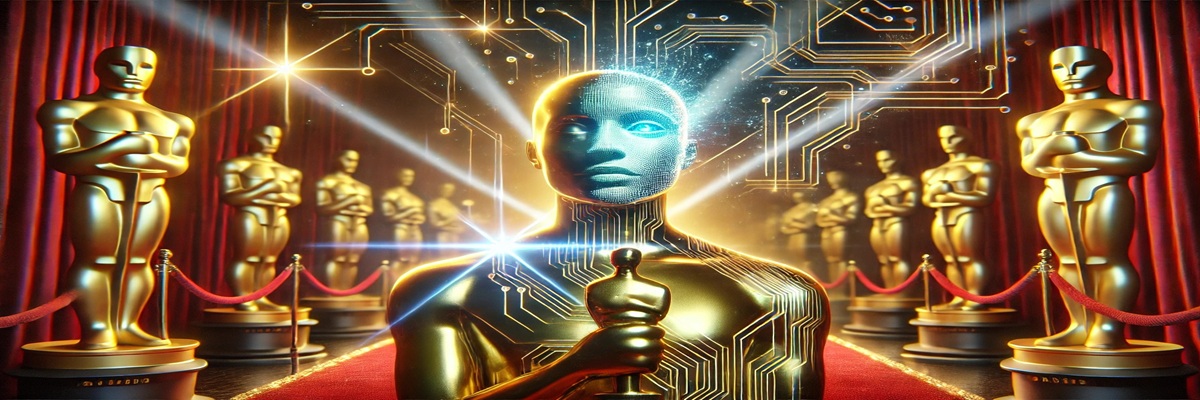A rising debate about artificial intelligence in Hollywood has intensified around two highly publicized developments. On one hand, the Oscars have faced mounting pressure to clarify where AI-generated content fits within their awards criteria, a question some see as central to the future of filmmaking. On the other, a pair of upcoming projects—The Brutalist, directed by Brady Corbet, and Emilia Pérez stand accused of venturing dangerously close to letting AI overshadow more traditional creative labor. Some watchers say they reflect the beginning of a new era where generative AI may supplant writers, animators, and, especially, voiceover artists, who face the possibility of studios replicating or synthesizing entire voice performances. This controversy goes beyond simple concerns of technological novelty, spilling into moral, legal, and labor-related battles that shape how we value human contribution in the cinematic arts.
A Friction Point at the Oscars Over AI
Ever since AI-based models proved their capability to produce believable text, imagery, and even voice lines, the conversation has turned to whether the Academy of Motion Picture Arts and Sciences (which oversees the Oscars) might accept or reject content that is partially machine-generated. Some observers recall that the Oscars have historically championed human achievement, focusing on categories such as Best Original Screenplay, Best Director, and Best Actor or Actress, each presumably rooted in human creativity. Now, the question arises: should an AI-driven script or digitally reconstructed performance be eligible for the same recognition?
Individuals intimately familiar with Academy deliberations note that awarding major honors to an AI-synthesized creation feels at odds with the spirit of the ceremony, which has for decades celebrated personal ingenuity and craft. Others, however, see no reason to exclude advanced technologies if the final result enthralls audiences. This tension plays out as certain production teams consider disclaimers that either highlight minimal or nonexistent AI usage, in effect guaranteeing that the “handmade” integrity of the film’s script, design, and voiceover remain untainted by algorithms. Such disclaimers, while not currently mandated, might become more common if the Academy expands guidelines that challenge producers to affirm the purely human origin of a film’s creative elements.
The Brutalist: Alleged AI Usage and Brady Corbet’s Defense
One of the controversies capturing attention revolves around The Brutalist, a film that rumors suggest uses AI in ways that overshadow or bypass standard creative processes. Some coverage of the matter has implied that generative AI tools might have replaced certain aspects of design or writing, thus calling into question whether the movie meets customary definitions of originality. Fueled by speculation, critics demanded clarity on whether entire scenes were partially produced by AI or if voice lines had been shaped through text-to-speech or machine-driven manipulations.
In response, the film’s director, Brady Corbet, countered that the project did not revolve around letting artificial intelligence handle significant creative tasks. He argued that while digital methods might expedite certain chores, no vital dimension—particularly screenwriting or main character voices—depended on an algorithm. Instead, Corbet emphasized that The Brutalist remains rooted in real human decisions: sets constructed by production designers, scripts hammered out by writers, and voiceover lines delivered by professional actors. Observers note that the confusion underscores the broader anxiety: as soon as a film appears visually or thematically experimental, rumors swirl that AI must be behind the scenes.
Yet the conversation rarely stops at visuals or writing alone. Many in the voiceover industry fear an environment where studios might deem a character’s lines “easy to replicate” with an AI model that has consumed data from thousands of prior performances. By disclaiming any major reliance on AI, Corbet effectively reaffirms his confidence in voice actors to breathe emotional life into their roles, preserving the intangible spirit of personal interpretation that a data model cannot authentically replicate.
Emilia Pérez: A Companion Controversy
The second major flashpoint concerns Emilia Pérez, another production rumored to tinker with advanced AI solutions. While the details remain murky, talk among insiders suggests that some element of the creative process—be it script generation, background design, or potentially even voiceover for supporting characters—crossed the line into machine-led territory. The name “Emilia Pérez” itself has become a shorthand reference for the perils and promises of this new technological wave, akin to how certain other controversies have come to symbolize deeper cultural debates.
For some, these controversies speak to legitimate opportunities. If AI can handle mundane chores such as background chatter or minor NPC lines, might that free up the real voice talent to concentrate on principal characters, fine-tuning comedic or dramatic nuance? Others see such arguments as a stepping stone to more expansive AI usage, culminating in a scenario where major roles no longer require living actors or voice artists. The possibility that an entire performance could be conjured from digital inputs—and then recognized at the Oscars or similar award ceremonies—troubles those invested in the personal dimension of artistic expression.
Oscars Confront the Future of AI-Driven Cinema
The Academy, while not officially stating new rules around AI usage, finds itself in the crossfire of these controversies. Observers question how the Oscars might handle a hypothetical film that integrates significant generative AI for set design, script outlines, or voiceover performances. Would that film’s success overshadow other pictures that rely purely on human collaboration, or would the Academy institute categories excluding AI-based roles from consideration?
Insiders suggest that some members of the Academy remain staunch defenders of human-led artistry, pointing out how intangible factors—an actor’s personal experiences, a writer’s intangible voice, or a voiceover artist’s subtle inflections—are what carry a film from the realm of technical accomplishment to that of emotional resonance. Others maintain that if the result effectively moves audiences, perhaps it should be recognized, regardless of how it was crafted.
In the background, union negotiations highlight the precarious spot that voiceover actors occupy. If a director or producer can feed an AI model with voice samples from various professionals, they might generate passable lines for minor characters or crowd scenes, removing the need for multiple voice actors. The fear is that such incremental usage may gradually erode the traditional pipeline in which each role—no matter how small—represents a potential livelihood for a talented human performer.
Why Voiceover is a Central Battleground
While the controversies swirl around visual design, script creation, or editing, the voiceover world emerges as especially threatened. Over the past few years, generative AI systems have improved drastically at speech synthesis, with certain models capable of cloning a voice from relatively limited samples. A number of tech startups now tout the ability to produce “actor-quality” vocal performances, raising alarms in the voice talent community about job security and creative credit.
Voice actors have historically stepped in for a wide range of roles, from lead characters in animated features to quick lines for side roles or background banter. Some have carved out entire careers through consistent gigs with major animation or game studios. If AI can replace many of these smaller parts, the stepping stones that help budding actors build a résumé might vanish, leaving a smaller group of top-tier performers who still hold marquee roles. More existentially, what if leading roles, especially in big-budget animations, become “AI voices” for which no actor receives a paycheck or residuals?
Unions have begun to call for tight restrictions that preserve the dignity of voice acting as a craft. They argue that intangible qualities such as comedic timing, emotional spontaneity, or a distinct accent cannot be meaningfully replicated by an algorithm. In practice, though, studios might weigh the cost savings of synthetic voices, particularly for one-off lines in crowd scenes or to fill in last-minute rewrites. The controversies around The Brutalist or Emilia Pérez highlight how easily watchers of the industry suspect that lines or entire roles might be “machine-made.” That suspicion alone can tarnish a production’s perceived authenticity.
Directors’ Disclaimers as a Marketing and Ethical Tool
One emerging trend is the possibility of disclaimers. Some major directors, rumored to be among them James Cameron, are said to be prepared to open films with statements confirming that “no generative AI was used.” In a climate where the Oscars themselves might bar or question AI-driven content, disclaimers function as an assurance that every script line, performance, and voice cameo emerged from humans. This approach can serve as a moral and marketing advantage, indicating that the film stands apart from uncertain or ethically murky methods.
Critics of disclaimers, however, consider them somewhat performative. They point out that digital technology is woven into every corner of filmmaking, from color correction to advanced compositing. The difference, proponents respond, is that generative AI can cross the boundary from tool to stand-in for genuine human creativity. If disclaimers show respect for voice actors, screenwriters, or character designers who worry about being rendered obsolete, then disclaimers might become an important hallmark of moral accountability for an industry in flux.
Potential Industry Responses and the Road Ahead
As the controversies evolve, studios may experiment with partial AI integration for background lines, concept designs, or quick animation fixes, while disclaiming it in main roles or narrative arcs. They might also adopt transparent credits that detail which aspects used AI, along with acknowledging any human labor replaced. The Oscars, for their part, may weigh introducing guidelines that clarify how to handle nominations if AI is found to have shaped essential creative tasks—particularly if it shaped voiceover to a large extent.
In the short term, The Brutalist director Brady Corbet has tried to quell rumors by specifying that the film remains grounded in real creative labor. If that alleviates public concerns and union unease, it might serve as a blueprint for other filmmakers to follow, ensuring they are open about the scope of AI usage from the outset. Meanwhile, the conversation around Emilia Pérez underscores that the fear of overshadowing artistry with generative models remains potent. Each rumor of AI infiltration in a major production sets off new tremors among the workforce.
The voiceover community, which stands at a critical intersection of technology and performance, finds itself uniquely vulnerable. Synthetic speech can be tempting for studios seeking convenience, but the question is whether audiences will accept line readings absent that spark of human spontaneity. If disclaimers highlighting human voice actors become standard, that could provide an anchor for an industry in search of stable ground. Alternatively, if public acceptance of AI grows, disclaimers could fade, normalizing the technology’s presence in mainstream films.
Where Hollywood Goes From Here
Despite the growing tensions around AI’s place in filmmaking—particularly with voice acting and script creation—Hollywood’s future likely involves a careful balance between embracing innovative tools and preserving the essential artistry on which the industry was built. As more big-name directors publicly assert their stances, either in disclaimers or in clarifications about their production pipelines, audiences will become more aware of when and how artificial intelligence factors into the final product. The Oscars, meanwhile, stand at a crossroads, faced with deciding whether to welcome or resist AI-driven movies, scripts, and performances. All the while, the voiceover community—keenly aware of how synthetic speech technology could overhaul hiring practices—remains on high alert.
The controversies linked to The Brutalist and Emilia Pérez underscore just how easily speculation can overshadow the work of real creators, especially when even a rumor of AI involvement arises. Yet they also highlight a broader pursuit of transparency, as many in the film and TV world wish to safeguard human-led storytelling. Voiceover professionals, particularly those affiliated with unions, will press for more robust contractual protections against unapproved likeness or voice replication. Much like the transition into the digital era decades ago, the infusion of AI need not be an existential threat if handled ethically, with labor discussions and disclaimers shaping best practices. Ultimately, whether AI emerges as a boon or a burden will depend on how each studio or director deploys it—and whether audiences, critics, and awarding bodies recognize the difference between assisting creative visions and replacing them wholesale.

